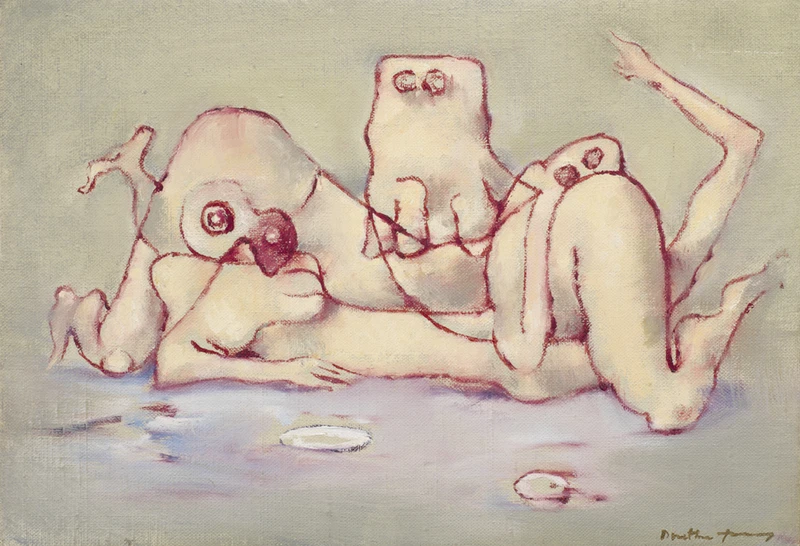Dorothea Tanning


b. 1910, United States
d. 2012
American painter, lithographer, and sculptor, 1910-2012
Dorothea Tanning (b.1910, Galesburg, Illinois, US; d.2012, New York, US) explored the disciplines of painting, sculpture, printmaking, collage, design, soft sculpture, installation and writing throughout her career. As a young artist, Tanning drew inspiration from Gothic and Romantic literature and Surrealism, creating fantastical and dream-like realms to investigate the human form and condition. As her work imagery and techniques evolved over the decades, she maintained an ambition to give form to imaginary worlds, as she explained in her 2001 memoir, Between Lives: An Artist and Her World: ‘I wanted to lead the eye into spaces that hid, revealed, transformed all at once and where there would be some never-before-seen image, as if it had appeared with no help from me.’1
After moving to New York in 1935, Tanning worked as a commercial artist to support herself, producing advertisements for clients including Macy’s department store. At first glance, her early oil paintings bear some resemblance to this commercial work, with detailed interiors and landscapes populated with finely drawn figures of women with their finery and flowers. Yet they also represent new freedom in their depictions of dreamscapes, nudity and more challenging themes. Her early images often feature domestic interiors, in which a door left ajar alludes to the threshold between spaces – sometimes ominous – between the conscious and the unconscious mind. In 1945, Tanning also designed costumes for George Balanchine’s ballet The Night Shadow, initiating a working relationship with him that would continue for the best part of a decade.
While Tanning’s early paintings invite the viewer to explore fantastical landscapes and architectural settings, in which multiple paths are open to the eye and the imagination, from the mid-1950s onwards, Tanning’s imagery became more abstract. Her brushstrokes became looser and more expressive, built up in gauze-like layers, veiling bodies that seem to be ecstatic in their movements. In departing from her earlier illusionistic style, she remained faithful to the figure, which evolved from a naturalistically rendered body to more mature, sensual, and often distorted feminine form.
Tanning never ceased to experiment beyond painting with different media and techniques. In the late 1960s through early 1970s, she worked in soft sculpture, stitching fabric and melding stuffed elements with items of furniture and architecture to create works that inhabited space in uncanny ways. Some of these soft sculptures evoke reclining figures and statuary from antiquity, while others are more dreamlike, emerging from the walls or conjoined with furniture. They culminated in an installation Hôtel du Pavot, Chambre 202, (Poppy Hotel, Room 202, 1970–73). In this sculptural room biomorphic human figures merge with and emerge from furniture, a hearth and the walls, literally breaking through the surface of the wallpaper. Her explorations also encompassed collages made from paper, photographs, photocopies and fabric whose torn elements recall the torn wallpaper as well as the clothing worn by the figures in her early paintings.
Tanning’s final paintings, made when she was in her 80s, are a series of 12 flowers, one for each month of the year, which she described in the accompanying book Another Language of Flowers (1998), as ‘naked, precise depictions of visions as real to me as botanical specimens are to the scientist’. These were in sense meditations on the relationship between images and poetry. Later in life, Tanning devoted herself more fully to her writing, producing two volumes of poetry, memoirs and a novel, Chasm: A Weekend (2004).
When she died in 2012 at the age of 101, Tanning’s life and work had spanned several historical epochs and cultural shifts, from modernity to postmodernity and the transition to a new millennium. Although Tanning lived through successive waves of feminism, she always resisted the idea that a woman’s art might be analysed according to different criteria than a man’s, asserting in 1990: ‘Women artists. There is no such thing – or person. It’s just as much a contradiction in terms as “man artist” or “elephant artist”.’2
1.Dorothea Tanning, Between Lives: An Artist and Her World (New York: W.W. Norton, 2001), p.214
2.‘Dorothea Tanning by Carlo McCormick’, BOMB Magazine, 1 October 1990